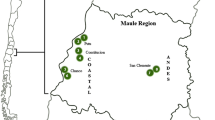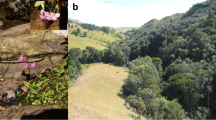Abstract
Gavilea australis is a terrestrial orchid endemic from insular south Argentina and Chile. Meeting aspects of mycorrhizal fungi identity and compatibility in this orchid species is essential for propagation and conservation purposes. These knowledge represent also a first approach to elucidate the mycorrhizal specificity of this species. In order to evaluate both the mycorrhizal compatibility and the symbiotic seed germination of G. australis, we isolated and identified its root endophytic fungal strains as well as those from two sympatric species: Gavilea lutea and Codonorchis lessonii. In addition, we tested two other strains isolated from allopatric terrestrial orchid species from central Argentina. All fungal strains formed coilings and pelotons inside protocorms and promoted, at varying degrees, seed germination, and protocorm development until seedlings had two to three leaves. These results suggest a low mycorrhizal specificity of G. australis and contribute to a better knowledge of the biology of this orchid as well as of other sympatric Patagonian orchid species, all of them currently under serious risk of extinction.




Similar content being viewed by others
References
Batty AL, Dixon KW, Brundrett M, Sivasithamparam K (2001) Constraints to symbiotic germination of terrestrial orchid seed in a Mediterranean bushland. New Phytol 152:511–520
Bonnardeaux Y, Brundrett M, Batty A, Dixon K, Koch J, Sivasithamparam K (2007) Diversity of mycorrhizal fungi of terrestrial orchids: compatibility webs, brief encounters, lasting relationships and alien invasions. Mycol Res 111:51–61
Broughton DA, McAdam JH (2002) A red data list for the Falkland Islands vascular flora. Oryx 36:279–287
Chemisquy MA (2012) Revisión taxonómica del género Gavilea: Orchidaceae, Chloraeinae. Darwiniana 50:33–80
Chemisquy MA, Morrone O (2012) Molecular phylogeny of Gavilea (Chloraeinae: Orchidaceae) using plastid and nuclear markers. Mol Phylogenet Evol 62:889–897
Chutima R, Dell B, Vessabutr S, Bussaban B, Lumyong S (2011) Endophytic fungi from Pecteilis susannae (L.) Rafin (Orchidaceae), a threatened terrestrial orchid in Thailand. Mycorrhiza 21:221–229
Correa MN (1969) Chloraea, género sudamericano de Orchidaceae. Darwiniana 15:374–500
Correa MN (1996) Orchidaceae, en F. Zuloaga y O Morrone (ed.). Catálogo de las plantas vasculares de la República Argentina I: 242–271
Dutra D, Kane ME, Richardson L (2009) Asymbiotic seed germination and in vitro seedling development of Cyrtopodium punctatum: a propagation protocol for an endangered Florida native orchid. Plant Cell Tiss Org 96:235–243
Fracchia S, Silvani V, Flachsland E, Terada G, Sede S (2013) Symbiotic seed germination and protocorm development of Aa achalensis Schltr., a terrestrial orchid endemic from Argentina. Mycorrhiza 1-9
Goloboff PA, Farris JS, Nixon KC (2008) TNT, a free program for phylogenetic analysis. Cladistics 24:774–786
Hall TA (1999) BioEdit: a user-friendly biological sequence alignment editor and analysis program for Windows 95/98/NT. Nucl Acid S 41:95–98
Harley JL, Smith SE (1983) Mycorrhizal symbiosis. Academic, London
Hopper SD, Brown AP (2007) A revision of Australia’s hammer orchids (Drakaea: Orchidaceae), with some field data on species-specific sexually deceived wasp pollinators. Aust Syst Bot 20:252–285
INDEC, Instituto Nacional De Estadísticas y Censos http://www.sig.indec.gov.ar/censo2010
Jaksic FM, Iriarte JA, Jiménez JE, Martínez DR (2002) Invaders without frontiers: cross-border invasions of exotic mammals. Biol Invasions 4:157–173
Katoh K, Toh H (2008) Recent developments in the MAFFT multiple sequence alignment program. Brief Bioinform 9:286–298
Masuhara G, Katsuya K (1994) In situ and in vitro specificity between Rhizoctonia spp. & Spiranthes sinensis (Persoon.) Ames. var. amoena (M. Beiberstein) Hara (Orchidaceae). New Phytol 127:711–718
McCormick MK, Jacquemyn H (2013) What constrains the distribution of orchid populations? New Phytol 202:392–400
McCormick MK, Whigham DF, Sloan D, O’Malley K, Hodkinson B (2006) Orchid–fungus fidelity: a marriage meant to last? Ecology 87:903–911
Neiland MRM, Wilcock CC (1998) Fruit set, nectar reward, and rarity in the Orchidaceae. Am J Bot 85:1657–1671
Novoa P, Espejo J, Cisternas M, Rubio M, Domínguez E (2006) Guía de Campo de las Orquídeas Chilenas. Corporación Chilena de la Madera, Concepción
Øien DI, O’Neill JP, Whigham DF, McCormick MK (2008) Germination ecology of the boreal-alpine terrestrial orchid Dactylorhiza lapponica (Orchidaceae). Ann Bot Fenn 45:161–172
Phillips RD, Barrett MD, Dixon KW, Hopper SD (2011) Do mycorrhizal symbioses cause rarity in orchids? J Ecol 99:858–869
Pridgeon A, Cribb PJ, Chase MW, Rasmussen FN (2003) Genera Orchidacearum, Orchidoideae (part two), Vanilloideae. Oxford University Press, Oxford
Rabassa J (2009) Impact of global climate change on glaciers and permafrost of South America, with emphasis on Patagonia, Tierra del Fuego, and the Antarctic Peninsula. Dev Earth Surf Process 13:415–438
Rasmussen HN (1995) Terrestrial orchid: from seed to mycotrophic plant. Cambridge University Press, Cambridge
Schinini A, Waechter J, Izaguirre P, Lehnebach C (2008) Orchidaceae. In: Zuloaga FO, Morrone O, Belgrano MJ (eds) Catálogo de las Plantas Vasculares del Cono Sur, vol 1. Monocotyledoneae. Missouri Botanical Garden Press, St Loius, pp 472–609
Shefferson RP, Weiss M, Kull TU, Taylor D (2005) High specificity generally characterizes mycorrhizal association in rare lady’s slipper orchids, genus Cypripedium. Mol Ecol 14:613–626
Skewes O, Rodriguez R, Jaksic FM (2007) Ecología trófica del jabalí europeo (Sus scrofa) silvestre en Chile. Rev Chil Hist Nat 80:295–307
Steinfort U, Verdugo G, Besoain X, Cisternas MA (2010) Mycorrhizal association and symbiotic germination of the terrestrial orchid Bipinnula fimbriata (Poepp.) Johnst (Orchidaceae). Flora 205:811–817
Stewart SL, Kane ME (2006) Symbiotic seed germination and in vitro seedling development of Habenaria macroceratitis (Orchidaceae), a rare Florida terrestrial orchid. Plant Cell Tiss Org 86:147–158
Stewart SL, Zettler LW (2002) Symbiotic germination of three semi-aquatic rein orchids Habenaria repens, H. quinquiseta, H. macroceratitis from Florida. Aquat Bot 72:25–35
Swarts ND, Dixon KW (2009) Terrestrial orchid conservation in the age of extinction. Ann Bot 104:543–556
Swarts ND, Sinclair EA, Francis A, Dixon KW (2010) Ecological specialization in mycorrhizal symbiosis leads to rarity in an endangered orchid. Mol Ecol 19:3226–3242
Taylor DL, Bruns TD, Leake JR, Read DJ (2003) Mycorrhizal specificity and function in myco-heterotrophic plants. In: van der Heijden MGA, Sanders I (eds) Mycorrhizal ecology. Springer, Berlin, pp 375–413
Thompson DW, Solomon S, Kushner PJ, England MH, Grise KM, Karoly DJ (2011) Signatures of the Antarctic ozone hole in Southern Hemisphere surface climate change. Nat Geosci 4:741–749
Tremblay RL, Zimmerman JK, Lebrón L, Bayman P, Sastre I, Axelrod F, Alers-García J (1998) Host specificity and low reproductive success in the rare endemic Puerto Rican orchid Lepanthes caritensis. Biol Conserv 85:297–304
Van Waes JM, Bebergh PC (1986) Adaptation of the tetrazolium method for testing the seed viability, and scanning electron microscopy study of some Western European orchids. Physiol Plant 66:435–442
White TJ, Bruns T, Lee S, Taylor J (1990) Amplification and direct sequencing of fungal ribosomal RNA genes for phylogenetics. In: Innis MA, Gelfand DH, Sninsky JJ, White TJ (eds) PCR protocols: a guide to methods and applications. Academic Press, New York, pp 315–322
Wu J, Ma H, Lü M, Han S, Zhu Y, Jin H, Xu J (2010) Rhizoctonia fungi enhance the growth of the endangered orchid Cymbidium goeringii. Botany 88:20–29
Yan N, Hu H, Huang JL, Xu K, Wang H, Zhou ZK (2006) Micropropagation of Cypripedium flavum through multiple shoots of seedlings derived from mature seeds. Plant Cell Tiss Org 84:114–118
Zelmer CD, Cuthbertson L, Currah RS (1996) Fungi associated with terrestrial orchid mycorrhizas, seeds and protocorms. Mycoscience 37:439–448
Acknowledgments
We thank Amelia Chemisquy for providing the pictures of Gavilea australis in their natural habitat.
Author information
Authors and Affiliations
Corresponding author
Rights and permissions
About this article
Cite this article
Fracchia, S., Aranda-Rickert, A., Flachsland, E. et al. Mycorrhizal compatibility and symbiotic reproduction of Gavilea australis, an endangered terrestrial orchid from south Patagonia. Mycorrhiza 24, 627–634 (2014). https://doi.org/10.1007/s00572-014-0579-2
Received:
Accepted:
Published:
Issue Date:
DOI: https://doi.org/10.1007/s00572-014-0579-2




